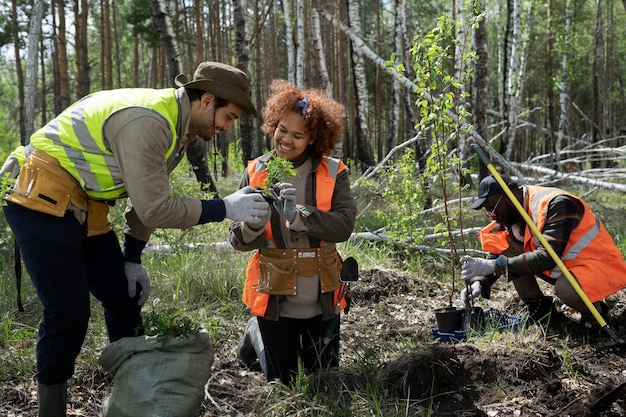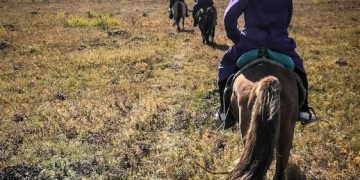Regenerative Travel in the US: Your Guide to Positive Impact

The Rise of Regenerative Travel: How to Leave a Positive Impact on US Destinations
Regenerative travel is a holistic approach to tourism focused on restoring and revitalizing destinations, ensuring that travel leaves a positive impact on the environment, local communities, and economies across the US.
Are you ready to travel in a way that not only allows you to explore the beauty of the United States but also contributes to its healing and prosperity? The Rise of Regenerative Travel: How to Leave a Positive Impact on US Destinations is more than just a trend; it’s a conscious choice to support thriving ecosystems and communities while experiencing authentic travel.
Understanding Regenerative Travel
Regenerative travel goes beyond sustainability. While sustainability aims to maintain the status quo, regenerative travel seeks to actively improve the environment and the well-being of local communities. It’s about creating a positive ripple effect with every trip.
This approach encourages travelers to engage deeply with the places they visit, understanding the cultural and ecological context and contributing to its restoration. It’s a holistic way to travel that benefits both the traveler and the destination.
Key Principles of Regenerative Travel
Regenerative travel is grounded in several core principles that guide travelers and tourism operators alike. These principles ensure that tourism contributes positively to the places visited.
- Environmental Restoration: Focuses on restoring ecosystems, conserving biodiversity, and reducing the carbon footprint of travel activities.
- Community Empowerment: Supports local businesses, cultural preservation, and the creation of economic opportunities for residents.
- Cultural Respect: Encourages travelers to learn about and respect local cultures, traditions, and heritage.
- Education and Awareness: Promotes education about regenerative practices and the importance of responsible travel.
By embracing these principles, travelers can ensure their trips contribute to the long-term health and vitality of US destinations.
In essence, regenerative travel is a way to travel that allows you enjoy the journey but also contribute to the well-being of the ecosystem and the communities you have visited, leaving a place in a better place than you found it.

The Benefits of Regenerative Tourism
Regenerative tourism offers a myriad of benefits, impacting not only the environment but also the social and economic fabric of the visited locales. These benefits extend an opportunity for travelers to not only experience new cultures and landscapes but also contribute actively to their well-being.
It provides a framework for tourism that moves beyond sustainability, actively contributing to thriving ecosystems, cultural preservation, and economic resilience.
Environmental and Ecological Benefits
By focusing on restoration and conservation, regenerative tourism enhances the health and resilience of natural environments.
- Biodiversity Conservation: Protecting and enhancing local flora and fauna.
- Ecosystem Restoration: Rehabilitating damaged natural habitats such as forests and wetlands.
- Carbon Sequestration: Reducing carbon footprints and promoting carbon-offsetting initiatives.
Social and Cultural Benefits
Regenerative tourism places a strong emphasis on respecting and supporting local cultures, which in turn fosters cultural pride and preservation.
- Cultural Preservation: Preserving and promoting local traditions, arts, and heritage.
- Community Empowerment: Supporting local businesses and creating economic opportunities.
- Enhanced Traveler Experiences: Providing more authentic and meaningful interactions with local communities.
Ultimately, the benefits of regenerative tourism range from ecological enhancement to enhanced cultural experiences, creating a positive virtuous cycle for all stakeholders involved.
Destinations Embracing Regenerative Practices
Across the United States, several destinations are leading the way in embracing regenerative travel practices. These locales demonstrate various strategies to make tourism sustainable, eco-friendly, and beneficial to locals and the environment.
These destinations are not just offering sustainable options; they are actively working to restore and enhance their natural and cultural heritage.

Examples of Regenerative Tourism Initiatives
These initiatives show how regenerative tourism can be implemented in diverse settings, supporting both the environment and local communities.
- Community-Based Tourism in National Parks: Indigenous-led travel programs that share cultural history and promote conservation.
- Sustainable Farming and Agri-tourism: Farms that use regenerative agricultural practices and offer educational tours and farm stays.
- Eco-Lodges and Resorts: Accommodations that prioritize environmental sustainability, community engagement, and cultural sensitivity.
These are just a few examples of how destinations across the US are embracing regenerative practices and creating more meaningful and impactful travel experiences.
How to Be a Regenerative Traveler
Becoming a regenerative traveler involves making conscious choices that positively impact the destinations you visit. This transformation requires thoughtful planning as well as a willingness to engage with local communities that may be significantly different than your own.
It means considering your impact and actively seeking ways to contribute to the restoration and well-being of the places you explore.
Tips for Planning a Regenerative Trip
Thoughtful planning is the backbone of regenerative tourism. With a few easy steps, you can optimize your tourist activities to be more eco-friendly and conscientious.
- Choose Destinations Wisely: Look for destinations that are committed to sustainability and regenerative practices.
- Support Local Businesses: Stay in locally owned accommodations, dine at local restaurants, and shop at local markets.
- Engage in Responsible Activities: Participate in activities that support conservation and community development.
What to Do During Your Trip
Transforming your tourist activities to be more positive is all about making small decisions that can result in a massive impact.
- Practice Responsible Consumption: Reduce waste, conserve water, and avoid single-use plastics.
- Respect Local Culture: Learn about local customs, traditions, and etiquette.
- Offset Your Carbon Footprint: Support carbon offsetting projects or choose transportation options with lower emissions.
Be sure to follow these steps and you may just find yourself on par with native attitudes and customs!
The Role of Businesses in Regenerative Travel
Businesses play a crucial role in advancing regenerative travel, guiding and providing travelers to minimize their impact. They can lead by example, implementing sustainable practices.
By adopting regenerative practices, businesses can create positive change and contribute to the long-term health of destinations.
Sustainable Business Practices
There are also several best practices that businesses can adopt to become more eco-friendly and positively benefit visitors as well as the local environment.
- Reducing Environmental Impact: Reduce waste, conserve energy, and minimize water usage.
- Supporting Local Communities: Source products and services from local suppliers and create job opportunities.
- Promoting Responsible Tourism: Educate travelers about regenerative practices and offer sustainable travel options.
Additionally, it is an imperative for businesses to be as transparent as possible and operate with maximal integrity.
Ultimately, the benefits and profitability that may be derived from regenerative tourism is directly correlated to the degree to which sustainability is promoted.
Challenges and Future Directions
While regenerative travel holds great promise, there are challenges to overcome. These challenges range from a general lack of awareness to a lack of regulations as well as operational constraints.
Addressing these challenges will be critical to realizing the full potential of regenerative travel in the US.
Addressing the Challenges
There are a multitude of constraints that may be keeping regenerative travel from being fully embraced.
- Raising Awareness: Educating travelers and businesses about the benefits of regenerative travel.
- Developing Standards and Certifications: Creating clear guidelines for regenerative practices.
- Promoting Collaboration: Encouraging collaboration between government, businesses, and communities.
In the long run, the success of regenerative tourism depends on the long-term viability and sustainability of a comprehensive effort.
Regenerative travel may be the best opportunity for destinations to not only survive, but thrive; as long as the needs, demands, and realities surrounding regenerative solutions are met.
| Key Point | Brief Description |
|---|---|
| 🌱 Environmental Restoration | Actively restoring ecosystems and conserving biodiversity. |
| 🤝 Community Empowerment | Supporting local businesses and creating economic opportunities. |
| 🌍 Cultural Respect | Respecting local cultures, traditions, and heritage. |
| 📚 Education & Awareness | Promoting education about regenerative practices. |
Frequently Asked Questions
▼
Regenerative travel aims to improve destinations. It goes beyond sustainability by actively restoring environments and supporting local communities, making a positive impact on every visit.
▼
Sustainable tourism seeks to minimize negative impacts, while regenerative travel actively enhances the visited destination. Regenerative travel focuses on restoring ecosystems and empowering local communities.
▼
Businesses can adopt sustainable practices. They can source locally, reduce their environmental impact, and educate travelers. Their actions positively influence the destinations they serve.
▼
Travelers can support local businesses. They can engage in responsible activities, respect local culture, and reduce waste. Every conscious decision contributes to a better travel experience.
▼
Examples include indigenous-led tourism. Also sustainable farming and agri-tourism, and eco-lodges. These initiatives blend cultural history with conservation creating unique eco-preservation methods.
Conclusion
Regenerative travel presents a transformative approach to tourism, seeking to create vacations with a positive impact on destinations throughout the US. By embracing regenerative values, you can travel with a clear conscience knowing that the world is left better off because you came.





